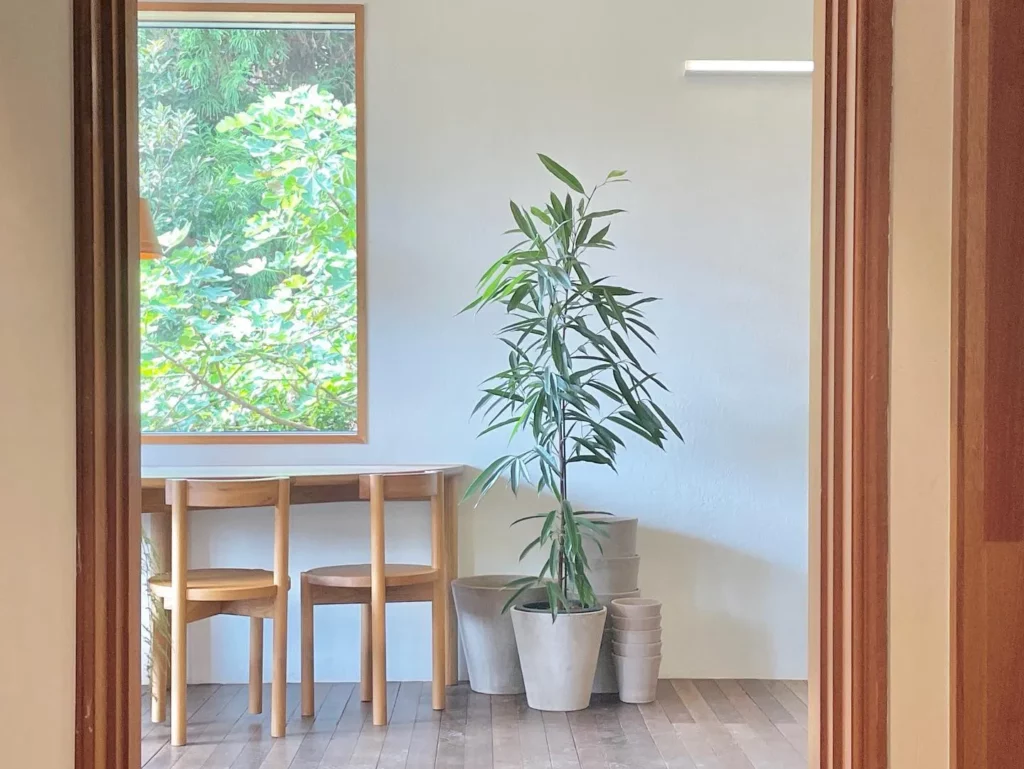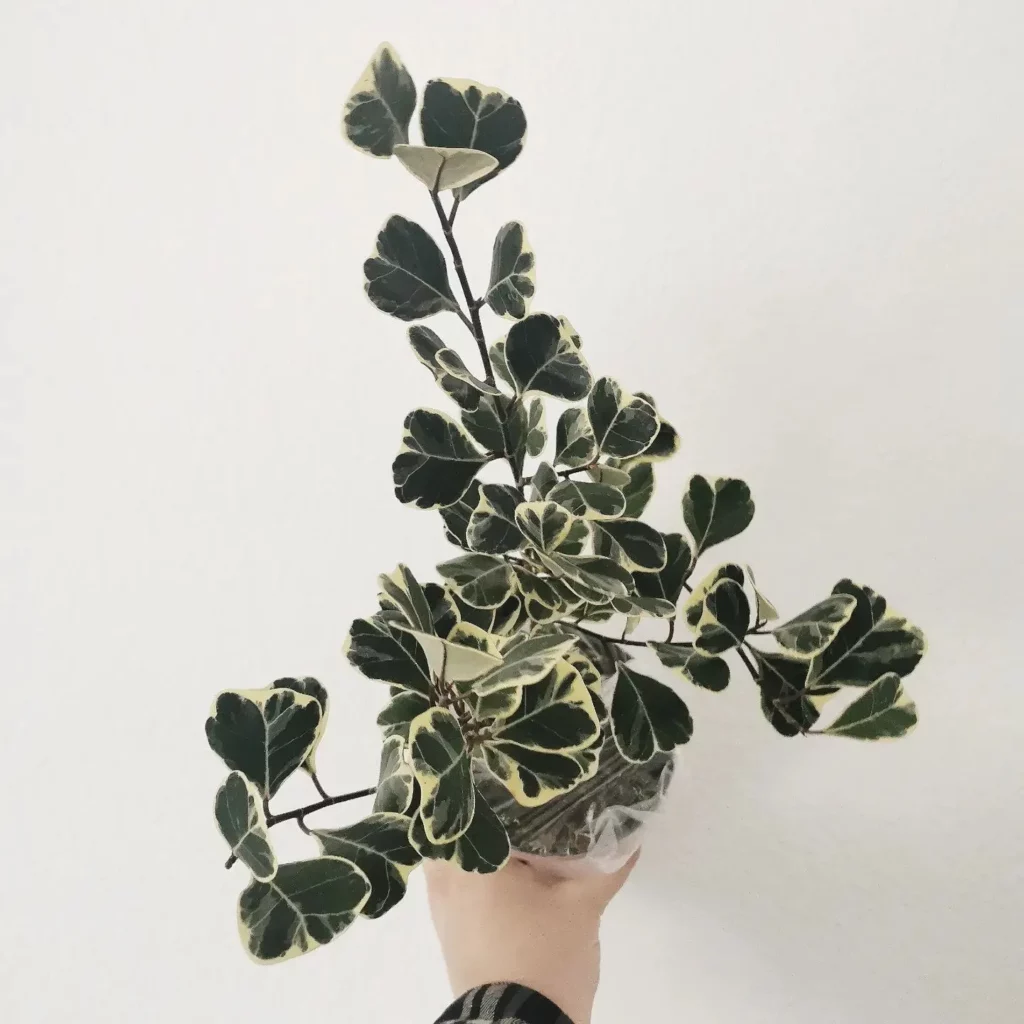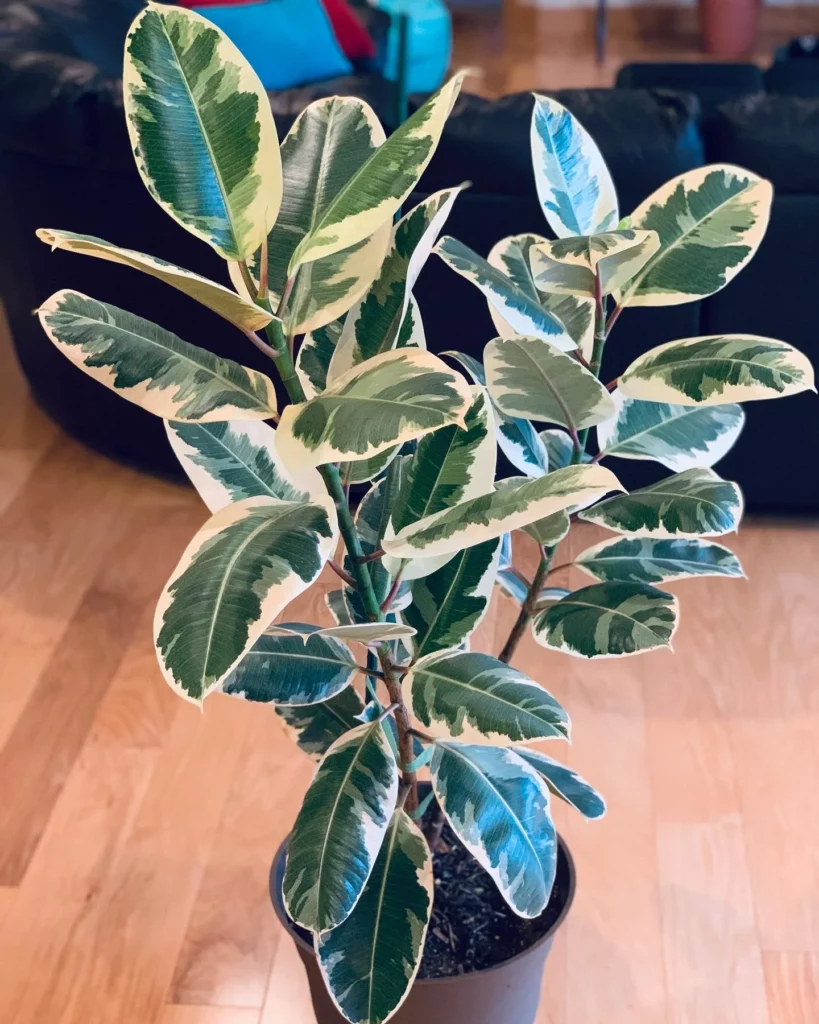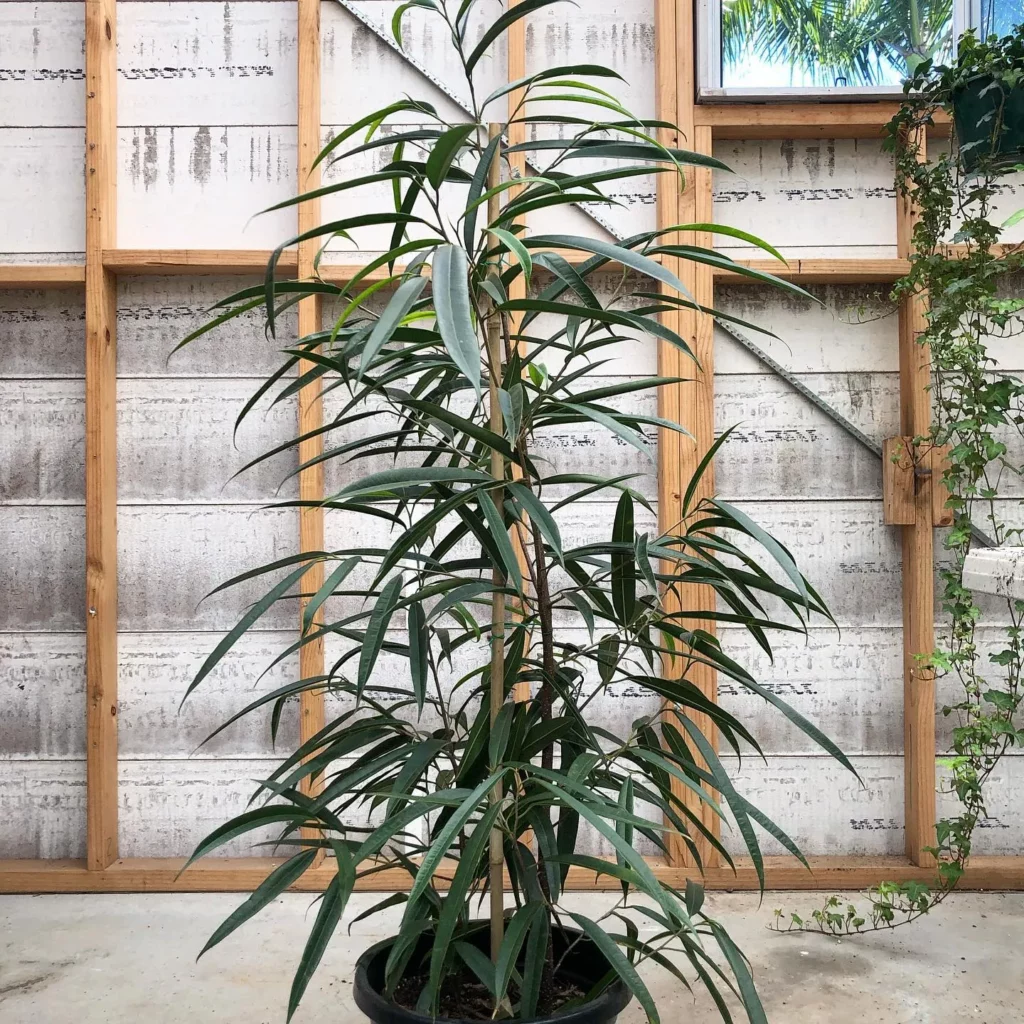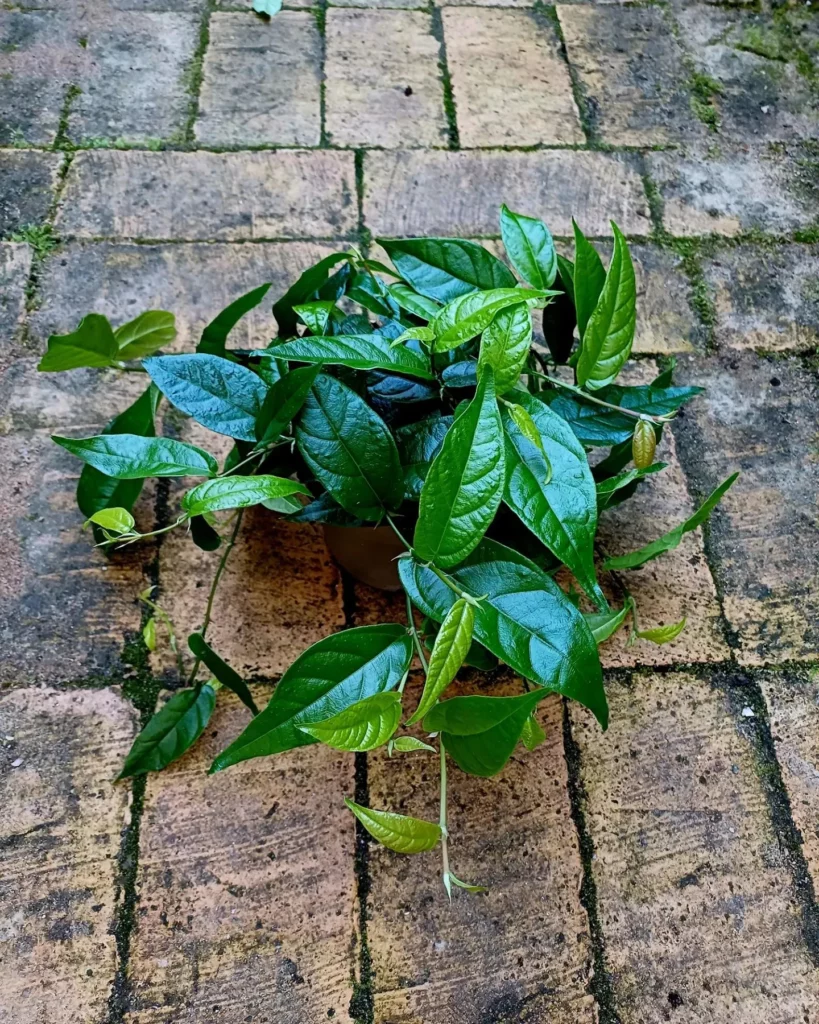The Ficus maclellandii (‘Alii’) is easily recognized by its long, slender leaves that resemble banana leaves and its tall, upright growth habit.
This unique appearance sets it apart from other ficus varieties, making it a popular choice for indoor plant enthusiasts. The elongated leaves add an elegant touch to any space, creating a sense of grace and beauty.
Appearance of Ficus maclellandii (‘Alii’)
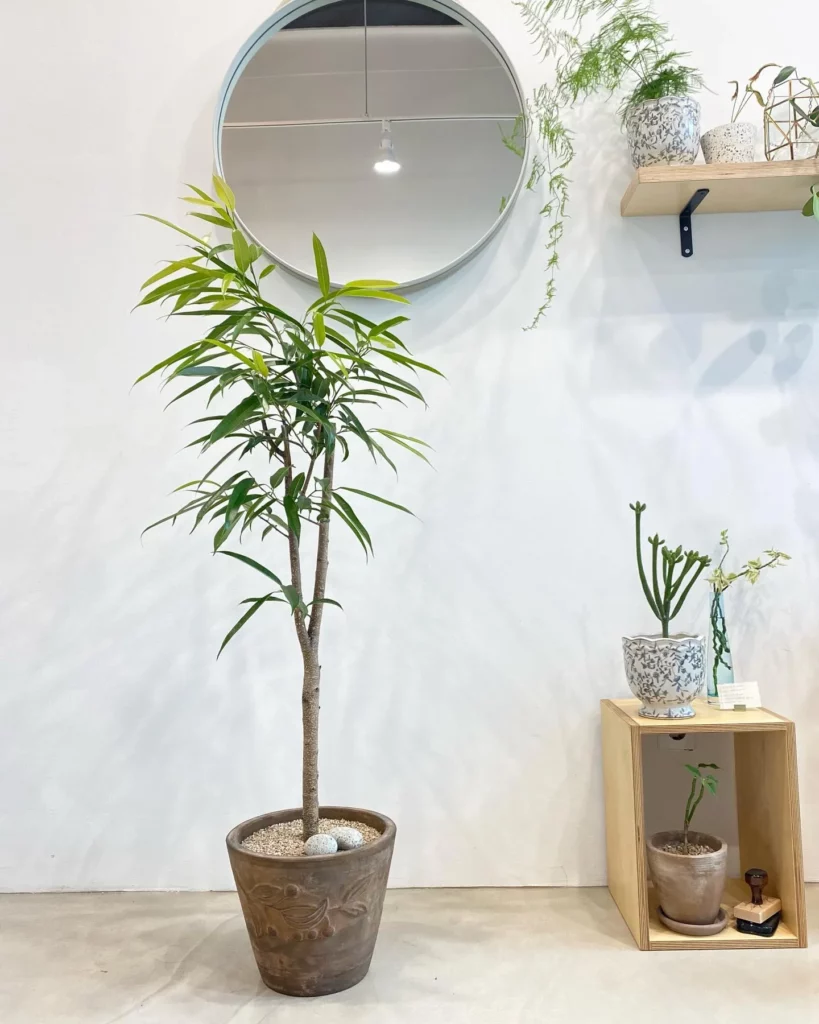
With its glossy green foliage, the Ficus Alii brings a touch of tropical charm to your home or office. The leaves grow in a dense arrangement, giving the plant a full and lush appearance.
The slender shape and pointed tips of the leaves add to its aesthetic appeal, creating a visually striking plant that is sure to catch the eye of anyone who enters the room.
To maintain the plant’s upright growth habit, it is important to provide proper support, such as a stake or trellis. This will help guide the plant’s growth and prevent it from leaning or becoming top-heavy.
With the right care and attention, the Ficus maclellandii (‘Alii’) can thrive and become a stunning focal point in any indoor space.
| Appearance | Care Tips |
|---|---|
| Long, slender leaves resembling banana leaves | Provide support for upright growth |
| Glossy green foliage | Rotate the plant periodically for even growth |
| Dense arrangement of leaves | Keep the plant away from drafts or direct sunlight |
| Slender shape with pointed tips | Ensure consistent moisture in the soil |
How To Grow Ficus maclellandii (‘Alii’)
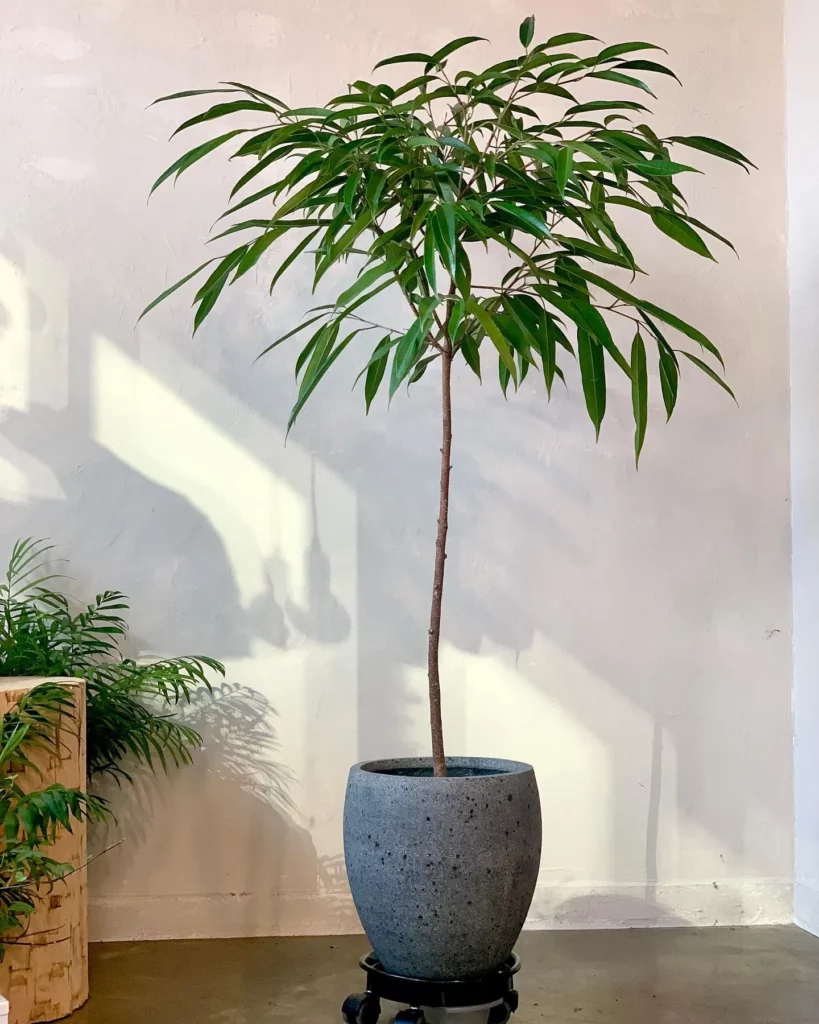
Growing Ficus maclellandii (‘Alii’) requires attention to specific environmental factors and proper care techniques to ensure its overall health and vitality.
With its elongated, banana-like leaves and graceful upright growth habit, this plant adds elegance to any indoor space. Here is a comprehensive guide on how to successfully grow and care for Ficus maclellandii (‘Alii’).
Propagation Tips for Ficus maclellandii (‘Alii’)
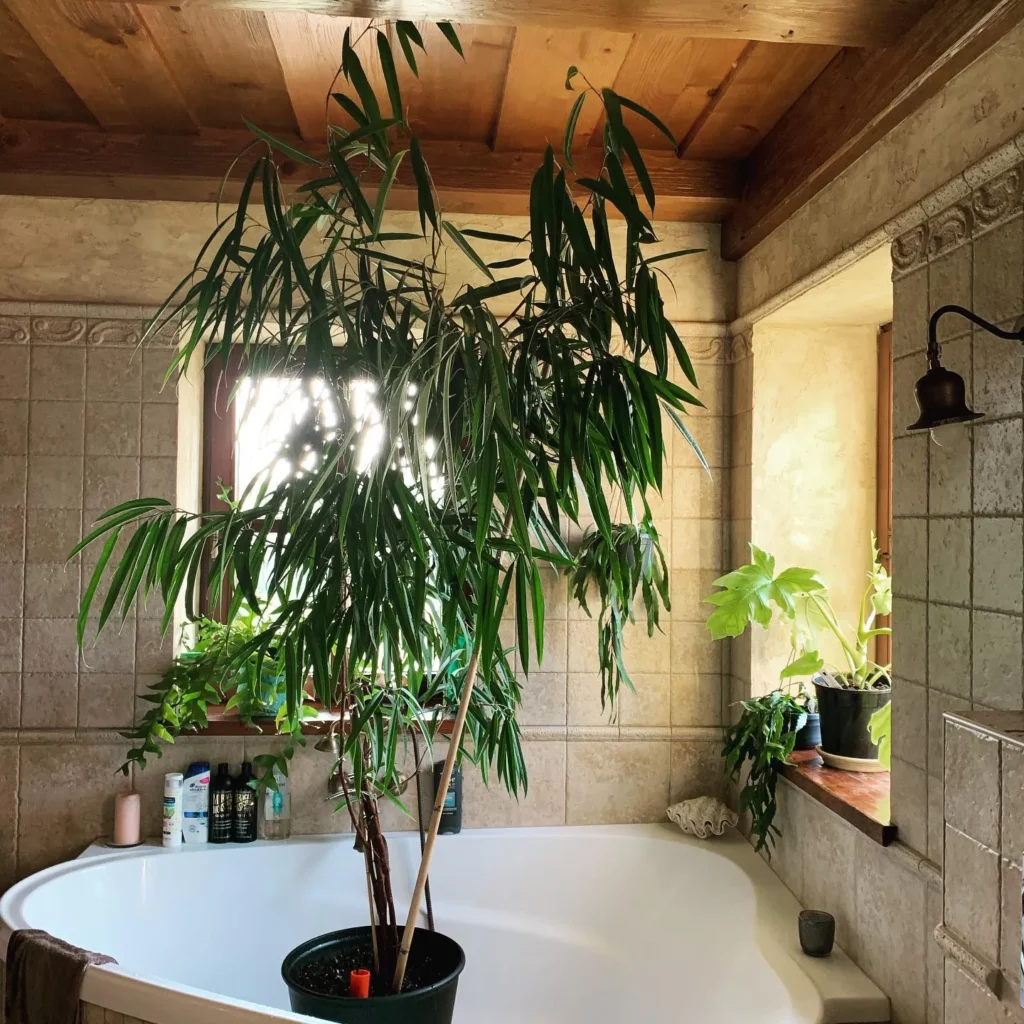
Propagating Ficus maclellandii (‘Alii’) can be an exciting and rewarding endeavor, allowing you to reproduce your favorite plant and share its beauty with others.
There are several methods you can use to propagate this stunning plant, including stem cuttings and air layering.
To propagate Ficus maclellandii (‘Alii’) through stem cuttings, follow these steps:
- Select a healthy stem from the parent plant, ensuring it has at least two or three nodes.
- Using a sharp, clean knife or pruning shears, make a clean cut just below a node.
- Remove any leaves from the lower portion of the cutting, leaving only a few at the top.
- Dip the cut end of the stem in rooting hormone to encourage root development.
- Plant the cutting in a well-draining potting mix, ensuring the node is below the soil surface.
- Place the pot in a warm area with bright indirect light and keep the soil consistently moist.
- After a few weeks, you should start to see new growth, indicating successful rooting.
Air layering is another effective method for propagating Ficus maclellandii (‘Alii’). Follow these steps:
- Select a healthy branch and make a small incision just below a node.
- Wrap the incision with moist sphagnum moss and cover it with plastic wrap to retain moisture.
- Secure the moss and plastic wrap in place with twine or plant ties.
- Keep the moss consistently moist, ensuring it doesn’t dry out.
- After a few weeks, roots should begin to develop within the moss.
- Once a sufficient root system has formed, carefully cut below the air layer and pot it up in a well-draining soil mix.
| Propagation Method | Advantages | Disadvantages |
|---|---|---|
| Stem Cuttings | Easy and straightforward | Success rate may vary |
| Air Layering | High success rate and faster root development | Requires more time and effort |
Quick Care Overview for Ficus maclellandii (‘Alii’)
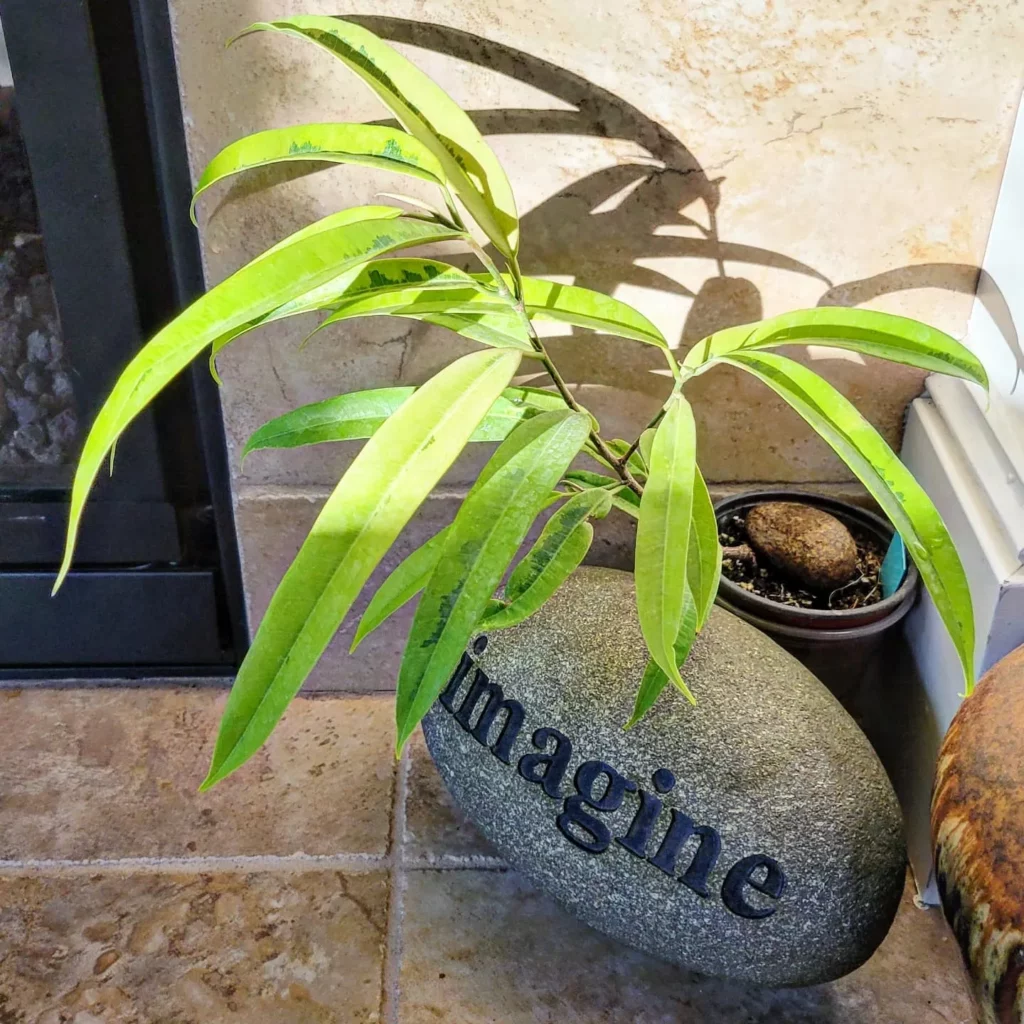
To make caring for your Ficus maclellandii (‘Alii’) easier, here’s a quick care overview highlighting the essential aspects of maintaining this stunning plant.
| Quick Care Overview | |
|---|---|
| Light | Bright indirect light |
| Soil | Well-draining mixture |
| Water | Keep soil consistently moist, water when top 1-2 inches dry |
| Temperature | 60-80°F |
| Humidity | Requires a humid environment |
| Fertilization | Once a month during spring and summer |
| Propagation | By stem cuttings or air layering |
| Pest Control | Watch for mealybugs and scales |
| Toxicity | Plant is toxic to humans and pets |
Light Requirements for Ficus maclellandii (‘Alii’)
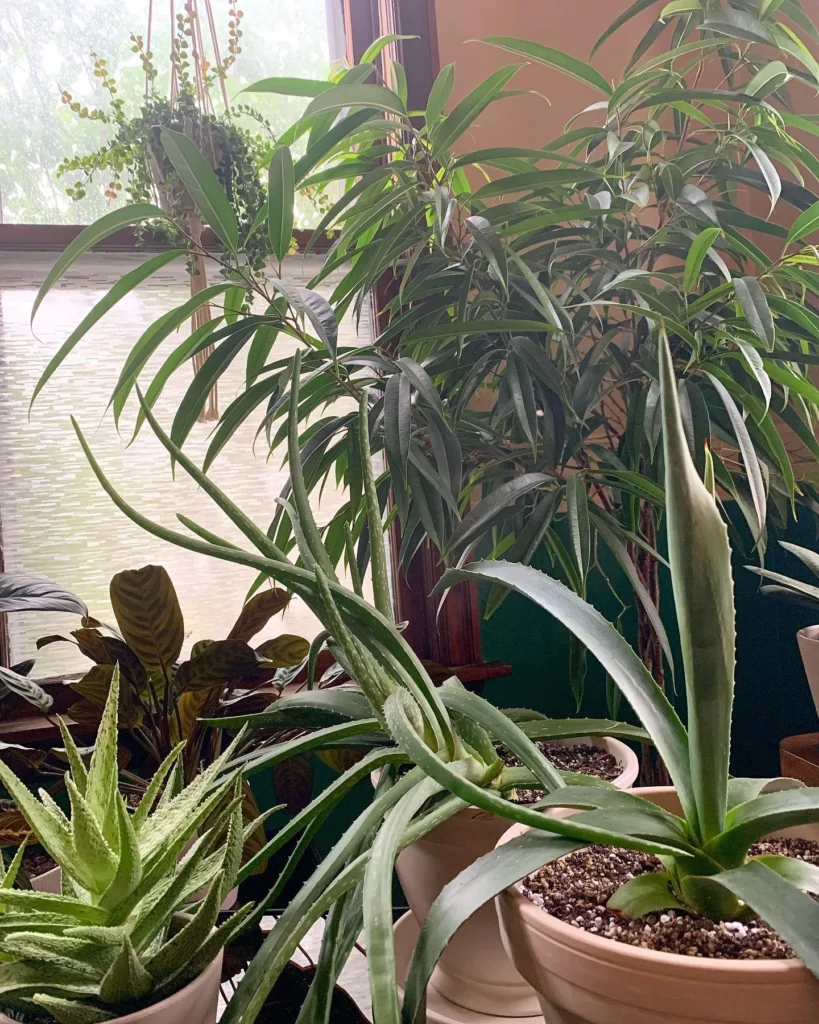
Proper lighting is essential for the healthy growth and development of Ficus maclellandii (‘Alii’). Let’s explore its light requirements and how to ensure your plant receives adequate illumination.
The Ficus Alii thrives in bright indirect light, making it perfect for well-lit indoor spaces. Place your plant near a window with filtered sunlight or in a spot where it can receive bright, indirect light throughout the day.
Avoid placing it in direct sunlight, as this can lead to leaf burn and damage.
If you notice your Ficus Alii leaning or reaching towards the light source, it may indicate insufficient light. Rotating your plant periodically will help promote even growth and prevent it from leaning towards one direction.
Lighting Tips for Ficus maclellandii (‘Alii’)
Here are a few tips to ensure your Ficus Alii receives the right amount of light:
- Rotate your plant every few weeks to promote even growth.
- If your Ficus Alii is placed far from a natural light source, consider supplementing with artificial grow lights.
- Avoid placing your plant near drafts or heating vents, as these can cause temperature fluctuations and affect its light requirements.
Soil Requirements for Ficus maclellandii (‘Alii’)

Creating a healthy root environment is essential for the overall well-being of your Ficus maclellandii (‘Alii’). Let’s explore the soil requirements and how you can ensure your plant gets the best soil for optimal growth.
The Ficus maclellandii (‘Alii’) thrives in well-draining soil that retains moisture without becoming waterlogged. A good potting mix for this plant consists of a combination of peat moss, perlite, and a quality indoor plant potting soil.
This mixture provides the right balance of moisture retention and adequate drainage to prevent root rot.
When potting or repotting your Ficus Alii, choose a container with drainage holes to allow excess water to escape. Proper drainage helps prevent waterlogged soil, which can lead to root rot and other fungal diseases.
It’s also important to select a container that is just slightly larger than the plant’s root ball to prevent excessive moisture buildup.
Recommended Soil Mixture for Ficus maclellandii (‘Alii’)
| Ingredients | Proportion |
|---|---|
| Peat moss | 40% |
| Perlite | 30% |
| Indoor plant potting soil | 30% |
Potting and Repotting Ficus maclellandii (‘Alii’)

Whether your Ficus maclellandii (‘Alii’) is in need of a new pot or it’s time for a routine repotting, understanding the process is crucial for maintaining the plant’s health and well-being. Proper potting and repotting techniques will ensure your Ficus Alii has a stable and nutrient-rich environment to thrive in.
Choosing the Right Container
When selecting a pot for your Ficus maclellandii (‘Alii’), opt for one that is slightly larger in size compared to the current container to allow room for growth. Ensure the new pot has drainage holes at the bottom to prevent water from pooling and causing root rot.
Preparing the Plant
Gently remove the Ficus Alii from its current pot, being careful not to damage the roots. If the roots are tightly bound, you can gently loosen them to encourage healthy growth. Inspect the roots for any signs of damage or disease and trim away any affected areas with clean, sharp scissors.
Creating the Growing Medium
In a separate container, prepare a suitable growing medium for your Ficus maclellandii (‘Alii’). Use a well-draining potting mix that contains a combination of peat moss, perlite, and organic matter.
This will provide the necessary nutrients and aeration for the plant’s roots to thrive.
| Growing Medium Ingredients: | Proportions: |
|---|---|
| Peat moss | 50% |
| Perlite | 30% |
| Organic matter (compost or leaf mold) | 20% |
Repotting the Plant
Place a layer of the prepared growing medium at the bottom of the new pot and lower the Ficus maclellandii (‘Alii’) into the center. Fill in the sides with the remaining growing medium, ensuring the roots are fully covered and supported.
Gently press down the soil to eliminate air pockets.
After repotting, water the plant thoroughly to help settle the soil around the roots. Avoid overwatering, as excessive moisture can lead to root rot.
Place the newly potted Ficus Alii in a location with bright indirect light and continue providing it with the proper care to promote healthy growth.
| Proper Potting and Repotting Tips for Ficus maclellandii (‘Alii’) |
|---|
| Choose a slightly larger pot with drainage holes for repotting |
| Loosen the roots and trim any damaged areas |
| Prepare a well-draining growing medium with peat moss, perlite, and organic matter |
| Repot the Ficus Alii, ensuring the roots are covered and supported |
| Water thoroughly after repotting and provide proper care for healthy growth |
Pruning and Shaping Ficus maclellandii (‘Alii’)
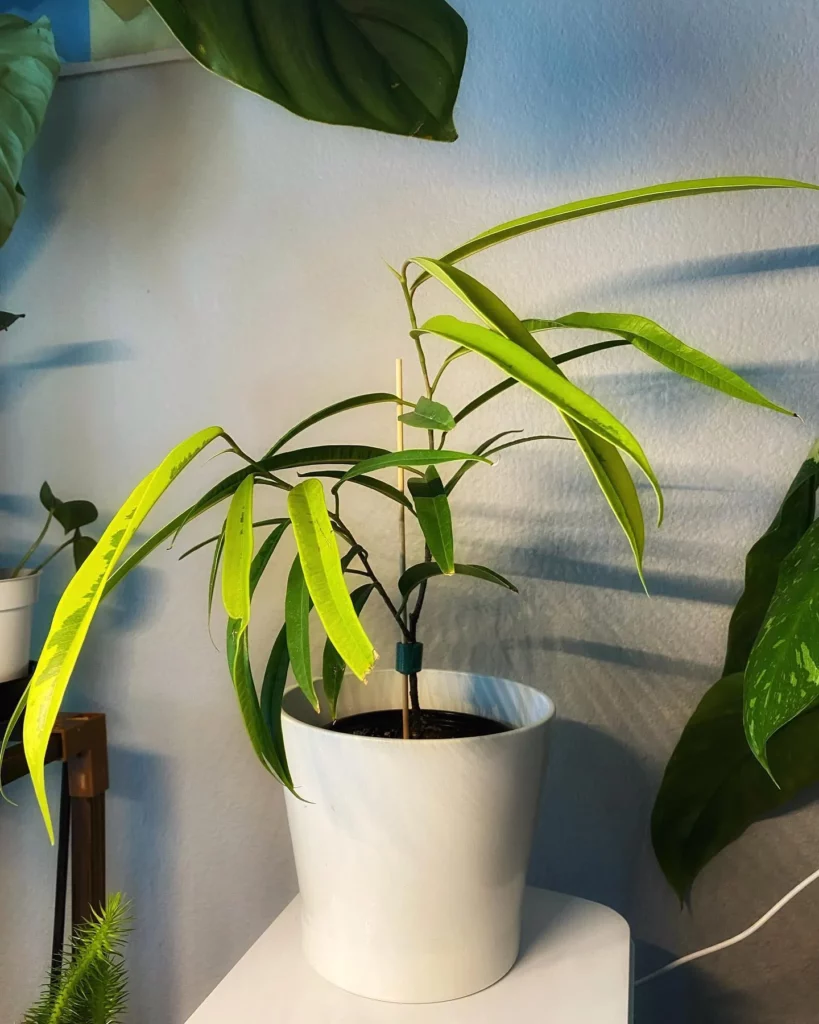
Pruning and shaping Ficus maclellandii (‘Alii’) not only enhances its aesthetics but also promotes a healthier and more compact growth habit.
By selectively removing overgrown or damaged branches, you can shape your plant to your desired form and size, creating a visually pleasing appearance.
When pruning, it’s important to use sharp, clean tools to prevent the spread of diseases. Start by removing any dead or yellowing leaves, as well as any branches that are crossing or rubbing against each other.
This will open up the plant, allowing for better air circulation and reducing the risk of pests and diseases.
If you want to encourage bushier growth, pinch the tips of the branches to stimulate branching in that area. This will result in a fuller and more compact plant. Additionally, you can selectively prune back long branches to maintain a more manageable size.
| Benefits of Pruning and Shaping Ficus maclellandii (‘Alii’) | Tips for Pruning Ficus maclellandii (‘Alii’) |
|---|---|
| Enhanced aesthetics: Pruning helps create a visually pleasing appearance and promotes a more compact growth habit. | Prune during the right time: Prune during the spring or summer months when the plant is actively growing. |
| Healthier growth: Removing dead or damaged branches allows for better air circulation and reduces the risk of pests and diseases. | Clean cuts: Make clean cuts just above a leaf node or branch intersection to promote proper healing. |
| Encourages bushier growth: Pinching the tips of branches stimulates branching, resulting in a fuller and more compact plant. | Disinfect tools: Disinfect your pruning tools before and after each use to prevent the spread of diseases. |
Temperature Requirements for Ficus maclellandii (‘Alii’)
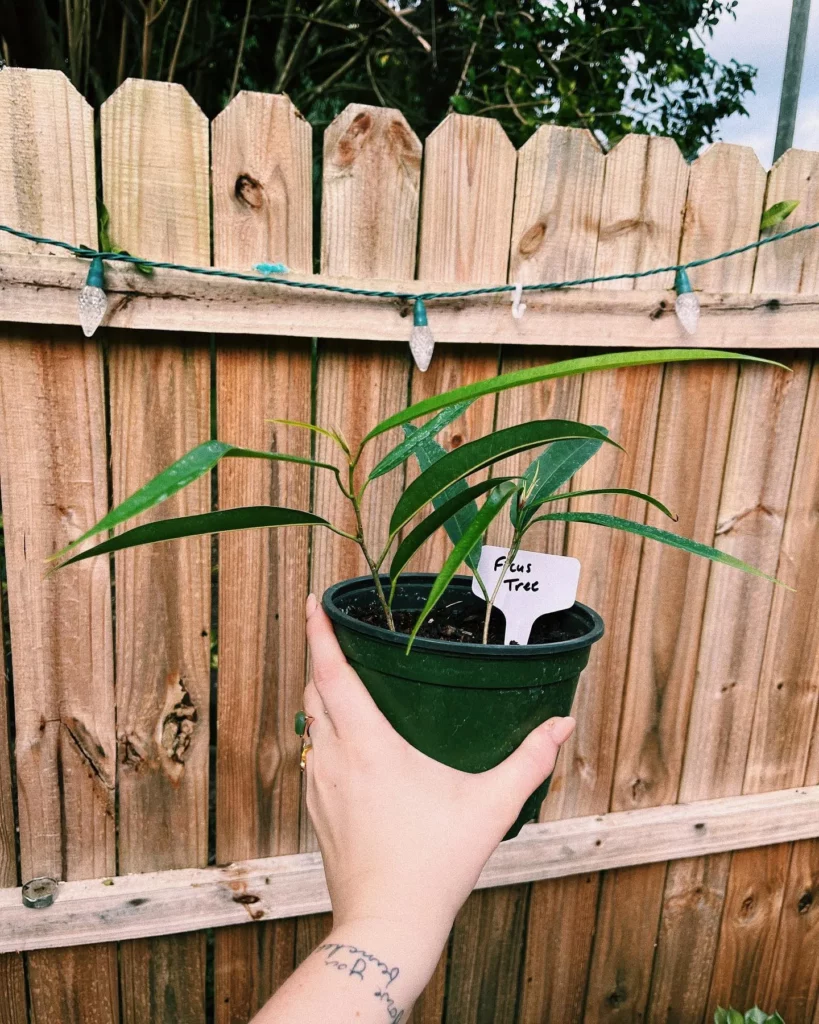
Providing the right temperature conditions is essential for the successful growth and development of Ficus maclellandii (‘Alii’). Let’s explore its temperature requirements and how you can maintain optimal conditions for your plant.
The Ficus maclellandii (‘Alii’) thrives in temperatures between 60-80°F (15-27°C). It prefers a warm and humid environment, mimicking its natural habitat in Southeast Asia.
Avoid exposing the plant to extreme temperature fluctuations and drafts, as they can stress the plant and lead to leaf drop.
To maintain a consistent temperature, place your Ficus Alii away from air conditioning vents, heaters, and windows that receive direct sunlight. You can also consider using a humidifier or placing the plant on a pebble tray filled with water to increase humidity levels around it.
During the winter months, when indoor heating can lead to drier air, it’s important to monitor the humidity levels and provide extra moisture if needed. Misting the leaves with water or using a humidifier can help create a more suitable environment for the Ficus Alii.
| Temperature | Conditions |
|---|---|
| 60-70°F (15-21°C) | Ideal temperature range for Ficus maclellandii (‘Alii’) |
| 70-80°F (21-27°C) | Acceptable temperature range for Ficus maclellandii (‘Alii’) |
Humidity Requirements for Ficus maclellandii (‘Alii’)
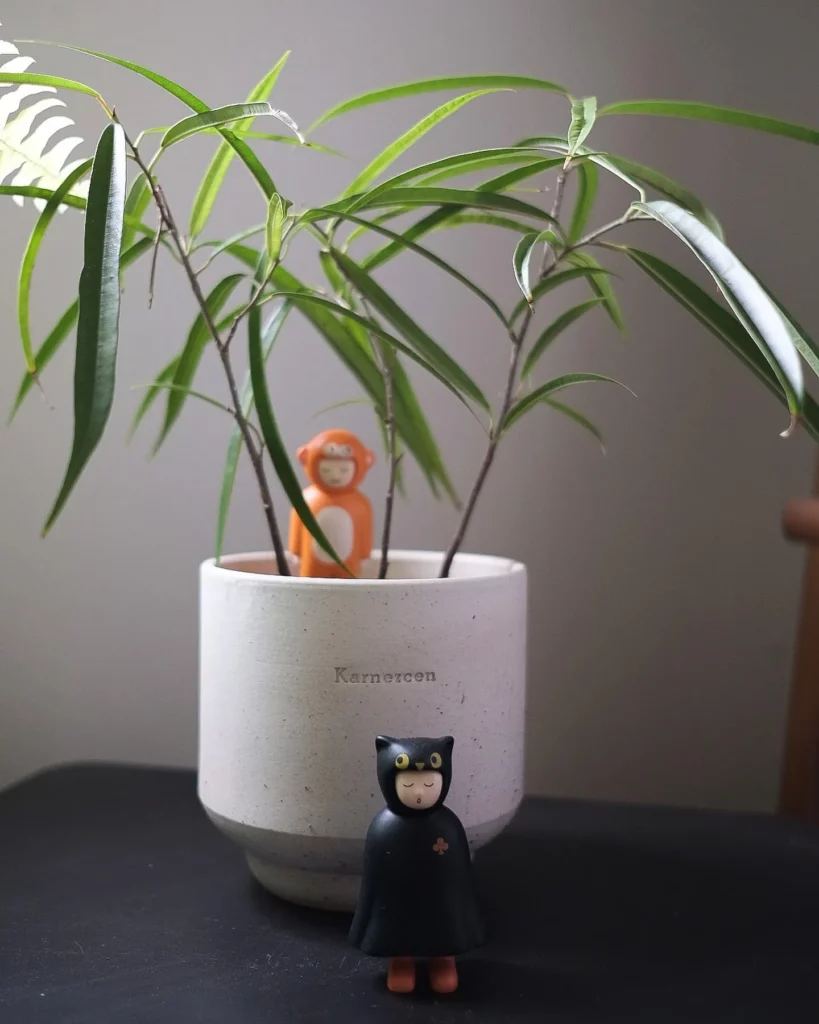
Creating an adequately humid environment is essential for the overall growth and vitality of Ficus maclellandii (‘Alii’). Let’s explore its humidity requirements and how you can provide the necessary moisture levels for your plant.
The Ficus Alii is a tropical plant native to southeastern Asia, India, and China. It naturally thrives in high humidity, so replicating these conditions in your home is crucial for its well-being.
The ideal humidity range for Ficus maclellandii (‘Alii’) is between 50% and 60%. Maintaining this level of humidity will help prevent the plant from drying out and developing issues like leaf curling or browning.
There are several ways you can increase humidity around your Ficus Alii. One effective method is to use a humidifier, especially in dry climates or during the winter months when indoor air tends to be drier.
Placing a tray filled with water near the plant or using a pebble tray can also help create a humid microclimate around the plant as the water evaporates.
| Humidity Level | Effects on Ficus maclellandii (‘Alii’) |
|---|---|
| Below 40% | Leaves may become dry and brown at the edges. The plant may be more susceptible to pests and diseases. |
| 40% – 50% | Ficus maclellandii (‘Alii’) can survive at this level, but it may not thrive. Leaves may show some signs of stress. |
| 50% – 60% | Ideal range for Ficus Alii. Leaves will remain healthy, vibrant, and free from issues caused by low humidity. |
| Above 60% | Excessive humidity can lead to fungal growth and root rot. Make sure to monitor humidity levels and provide adequate airflow. |
Watering Ficus maclellandii (‘Alii’)
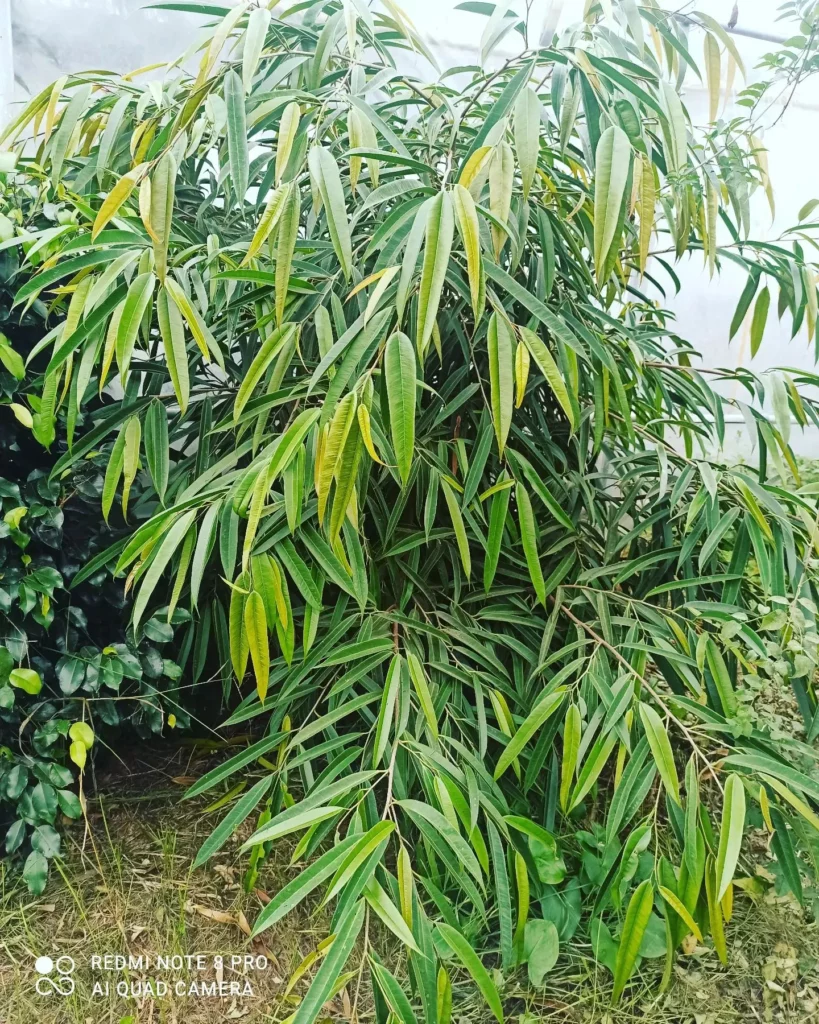
Watering your Ficus maclellandii (‘Alii’) correctly is crucial for promoting healthy growth and preventing issues such as overwatering or underwatering.
This plant prefers consistently moist soil, but it’s important to avoid waterlogged conditions as it can lead to root rot. To ensure proper watering, check the moisture level of the soil by inserting your finger about an inch deep.
If the soil feels dry at this depth, it’s time to water your Ficus Alii.
When watering, pour water evenly over the soil until it starts to drain from the bottom of the pot. This helps to achieve thorough hydration while allowing excess water to escape.
Remember to empty the saucer beneath the pot to prevent standing water, which can attract pests and promote fungal growth.
During winter months when the plant is in a dormant phase, you can reduce watering frequency. However, be sure to monitor the moisture level to prevent the soil from completely drying out. Consistency is key when it comes to watering your Ficus maclellandii (‘Alii’) to maintain its health and vitality.
Watering Recommendations for Ficus maclellandii (‘Alii’)
| Season | Watering Frequency |
|---|---|
| Spring and Summer | Water thoroughly when top 1-2 inches of soil is dry |
| Fall | Water moderately, allowing the soil to dry slightly between waterings |
| Winter | Reduce watering, water when the top inch of soil is dry |
Gauging Watering Needs
It’s important to note that the frequency of watering may vary depending on several factors, including the size of the pot, the temperature and humidity levels in your home, and the amount of light your Ficus maclellandii (‘Alii’) receives. Keep a close eye on the plant and adjust your watering schedule accordingly to maintain optimal moisture levels.
Fertilizing Ficus maclellandii (‘Alii’)
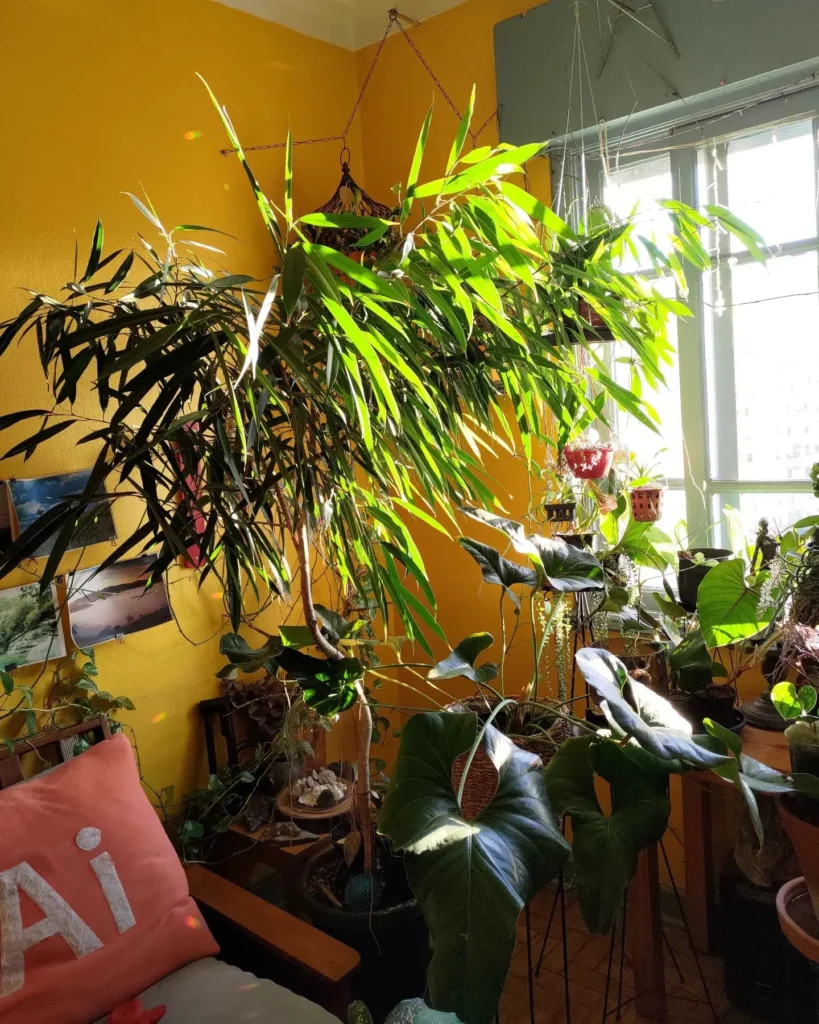
Providing your Ficus maclellandii (‘Alii’) with proper nutrition is essential for its overall well-being and vitality. Let’s explore how and when to fertilize your plant to ensure its optimal growth.
When it comes to fertilizing Ficus maclellandii (‘Alii’), a balanced approach is key. Start by selecting a well-balanced liquid fertilizer, preferably one formulated specifically for indoor plants.
This will ensure that your Ficus Alii receives the necessary macro and micronutrients it needs to thrive.
During the active growing season, which typically spans from spring to summer, fertilize your Ficus Alii once a month. Dilute the fertilizer according to the manufacturer’s instructions, and apply it to moist soil.
Be sure to water your plant before fertilizing, as this will help prevent any potential root burn.
| Fertilizing Frequency | Fertilizer Type |
|---|---|
| Spring to Summer | Once a month |
| Fall to Winter | Every two to three months |
Pest Control for Ficus maclellandii (‘Alii’)
Dealing with pests can be a challenge, but with the right techniques and preventive measures, you can protect your Ficus maclellandii (‘Alii’) from common invaders.
One of the most common pests that can affect your Ficus Alii is the mealybug. These tiny insects are covered in a white, powdery substance and can suck the sap from the plant, leading to weak and stunted growth.
To control mealybugs, you can use a cotton swab dipped in rubbing alcohol to remove them from the plant. Additionally, you can apply insecticidal soap or neem oil to eliminate these pests.
Another pest that can pose a threat to your Ficus Alii is the scale insect. These pests attach themselves to the stems and leaves of the plant and can cause yellowing and wilting. To control scale insects, you can use a soft brush or cloth to physically remove them from the plant.
| Pest | Control Methods |
|---|---|
| Mealybugs | Remove with rubbing alcohol Apply insecticidal soap or neem oil |
| Scale Insects | Physically remove with a brush or cloth Introduce natural predators Use horticultural oil or insecticidal soap |
Common Problems and Troubleshooting for Ficus maclellandii (‘Alii’)
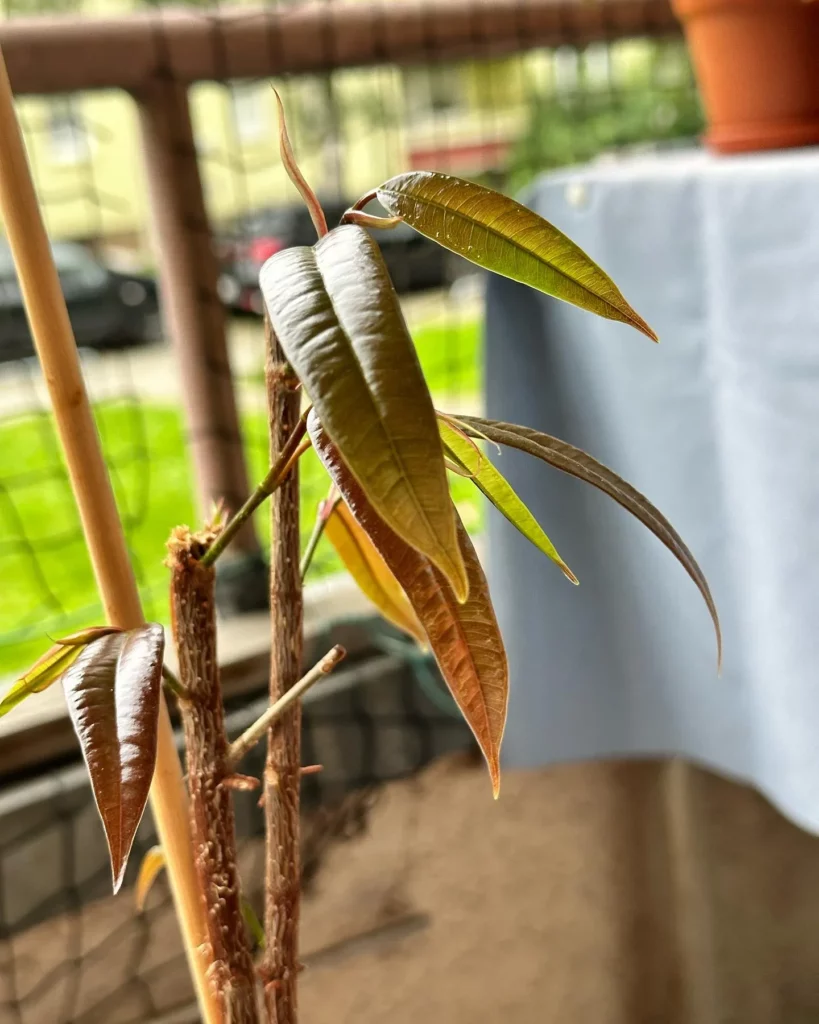
While Ficus maclellandii (‘Alii’) is relatively easy to care for, it is not immune to problems. Let’s explore common issues that may arise and how to troubleshoot them for a healthy plant.
Potential Problems
1. Leaf Drop: One of the most common issues with Ficus maclellandii (‘Alii’) is leaf drop. This can be caused by factors such as transplant shock, overwatering, or inconsistent watering.
To remedy this, ensure your plant is in a suitable pot with well-draining soil. Be mindful of overwatering and aim for consistent watering, allowing the top 1-2 inches of soil to dry out between waterings.
2. Pests: Ficus maclellandii (‘Alii’) can be prone to pests such as mealybugs and scales. If you notice small, cotton-like white masses on the leaves or stems, or if you see tiny, brown, oval-shaped insects, take action immediately.
Remove any visible pests with a cotton swab dipped in rubbing alcohol and regularly inspect the plant for signs of infestation. Consider using natural pest control methods or insecticidal soap if the infestation persists.
Common Diseases
1. Root Rot: Overwatering or poorly-draining soil can lead to root rot, which is caused by fungal infections. If you notice soft, mushy roots or a foul smell coming from the soil, it is likely that your plant is suffering from root rot.
To address this, remove the plant from its pot and inspect the roots. Trim away any affected roots, repot the plant in fresh, well-draining soil, and adjust your watering practices to prevent future issues.
2. Leaf Spot: Leaf spot is a fungal disease that causes dark spots or blotches on the leaves. It can be caused by overwatering, poor air circulation, or high humidity levels.
To treat leaf spot, remove any affected leaves and improve air circulation around the plant. Adjust your watering practices to prevent excessive moisture on the leaves, and consider using a fungicide if the problem persists.
Tips for Prevention
1. Provide Adequate Lighting and Air Circulation: Ficus maclellandii (‘Alii’) thrives in bright indirect light and benefits from good air circulation. Place your plant near a window with filtered sunlight, and consider rotating it periodically to ensure even growth.
2. Maintain Proper Watering: Avoid overwatering or allowing the soil to dry out completely. Aim for consistent moisture by watering when the top 1-2 inches of soil feels dry. Use a well-draining potting mix to prevent waterlogged soil.
3. Monitor Humidity Levels: Ficus maclellandii (‘Alii’) prefers a humid environment, so consider using a humidifier or placing a tray of water near the plant to increase humidity levels. Avoid placing the plant near drafts or vents that can cause dry air.
Conclusion
I hope this comprehensive care guide has empowered you with the knowledge and confidence to successfully care for your Ficus maclellandii (‘Alii’) and enjoy its beauty for years to come.
The Ficus maclellandii (‘Alii’), also known as the Banana Leaf Fig, is a popular plant native to southeastern Asia, India, and China. It is favored by many plant enthusiasts for its elegant appearance and relatively low maintenance requirements.
When it comes to caring for your Ficus Alii, it’s important to provide it with the right environmental conditions. This plant thrives in bright indirect light, so be sure to place it near a window with filtered sunlight.
Rotate the plant periodically to ensure even growth and prevent it from leaning towards the light source.
Proper watering is crucial for the health of your Ficus Alii. Keep the soil consistently moist, but be careful not to overwater. Water the plant when the top 1-2 inches of soil are dry.
Maintaining a humid environment is also important, so consider using a humidifier or placing a tray of water near the plant.
Regular fertilization during the spring and summer months will provide the necessary nutrients for your Ficus Alii to thrive. Repotting every 18-24 months will also help ensure the plant has enough space to grow.
Keep an eye out for common issues such as dropping leaves, which can be caused by transplant shock or incorrect watering, and pests such as mealybugs and scales. If necessary, take appropriate measures to address these problems.
Remember, the Ficus Alii is toxic to humans and pets, so handle it with care and keep it out of reach of children and animals. With proper care and attention, your Ficus maclellandii (‘Alii’) will bring beauty and life to your home for years to come.
Make sure to check out our article on Ficus maclellandii Banana-leaf Ficus Care Guide. And after reading that Ficus article, check out our article on Ficus microcarpa Ginseng Care Guide.
FAQ
Q: How often should I water my Ficus maclellandii (‘Alii’)?
A: Water your Ficus maclellandii (‘Alii’) when the top 1-2 inches of soil is dry. Ensure the soil is consistently moist but not waterlogged.
Q: What kind of light does the Ficus maclellandii (‘Alii’) prefer?
A: The Ficus maclellandii (‘Alii’) prefers bright indirect light. Place it in a location where it can receive filtered sunlight or artificial light.
Q: How often should I fertilize my Ficus maclellandii (‘Alii’)?
A: Fertilize your Ficus maclellandii (‘Alii’) once a month during the spring and summer using a balanced liquid fertilizer diluted to half strength.
Q: How often should I rotate my Ficus maclellandii (‘Alii’)?
A: Rotate your Ficus maclellandii (‘Alii’) every few months to ensure even growth and prevent the plant from leaning towards the light source.
Q: How often should I repot my Ficus maclellandii (‘Alii’)?
A: Repot your Ficus maclellandii (‘Alii’) every 18-24 months to provide it with fresh soil and room for growth.
Q: What temperature range is ideal for the Ficus maclellandii (‘Alii’)?
A: The Ficus maclellandii (‘Alii’) prefers temperatures between 60-80°F (15-27°C).
Q: What should I do if my Ficus maclellandii (‘Alii’) is dropping leaves?
A: Leaf drop in Ficus maclellandii (‘Alii’) can be caused by transplant shock or incorrect watering. Ensure you are providing the right amount of water and avoid sudden temperature changes.
Q: Are there any pests that can affect my Ficus maclellandii (‘Alii’)?
A: Yes, common pests that can affect your Ficus maclellandii (‘Alii’) include mealybugs and scales. Regularly inspect your plant for signs of infestation and take appropriate measures to control them.
Q: Is the Ficus maclellandii (‘Alii’) toxic to humans and pets?
A: Yes, the Ficus maclellandii (‘Alii’) is toxic to humans and pets. Take care when handling the plant and keep it out of reach of children and pets.
Q: How can I propagate my Ficus maclellandii (‘Alii’)?
A: Ficus maclellandii (‘Alii’) can be propagated through stem cuttings. Take a 6-inch cutting from the tip of a healthy stem and place it in a well-draining potting mix. Keep the soil moist and provide bright indirect light until roots develop.
Q: What are some common diseases that can affect my Ficus maclellandii (‘Alii’)?
A: Common diseases that can affect Ficus maclellandii (‘Alii’) include root rot, leaf spot, and powdery mildew. Ensure proper watering practices and maintain good air circulation to prevent these diseases.

